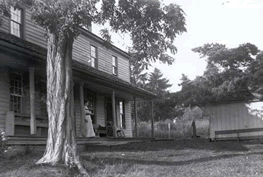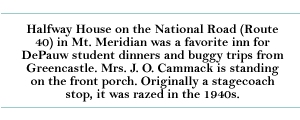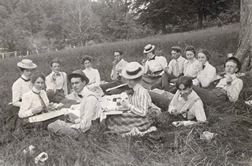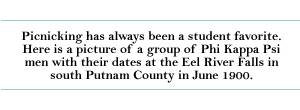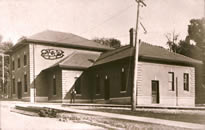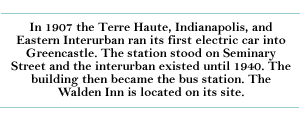
|
DePauw
students did not spend all their time in classrooms, dormitories,
boarding houses, or fraternity and sorority houses. The natural
beauty of Putnam County invited excursions into the countryside,
normally in this period by horse and carriage rented from a local
livery stable. One of the more popular resorts was Cataract, or
Eel River, Falls in the southern part of the county. Here two small
waterfalls - the Upper Falls and the Lower Falls - were surrounded
by a shady glade providing a perfect setting for picnic lunches
and sightseeing walks. An equally long and pleasurable ride took
one to the Cliffs of Fern, near the Fern Station of the Vandalia
Railroad about 12 miles west of Greencastle. The large sandstone
cliffs "covered with rare giant ferns and moss with good cold
spring water available" along with the virgin hardwood forest,
wild flowers, and meandering creek attracted students to the spot
for recreation as well as for botany field trips. At one time it
became so popular that the railroad ran excursion trains to it from
Terre Haute and Indianapolis.
A
place students often visited closer to campus was McLean Springs,
near Limedale on the Manhattan Road within hiking distance of the
campus. The clear springs here were so attractive that plans were
formulated to bring in electric lights and make it a summer resort,
but nothing came of the idea. A shorter walk south of the city took
one to Forest Hill Cemetery with its grassy slopes among the tombstones.
To the west was Sunset Hill, along the ridges behind present-day
Blackstock Stadium, where student sweethearts could watch the evening
star appear. Another place was the "Wall," a stone farm
fence along Indianapolis Road at its juncture with Franklin Street
about where the McDonald's franchise is today. Pittman's Pond on
the site of the Quonset hut used as a university store room was
available for boating in summer and skating in winter.
Affording students an escape route to the joys of big city life was
the Terre Haute, Indianapolis, and Eastern Interurban Railroad which
ran through Greencastle from 1907 to 1940. An hour's trip
brought one to the "sin city" of Terre Haute or to Indianapolis for
shopping, dining, or the theatre. Whole carloads of students
boarded the train at the interurban station located on the present
site of the Walden Inn to attend oratorical contests or athletic
events. |
Depauw University e-history | E-mail comments to: archives@depauw.edu

